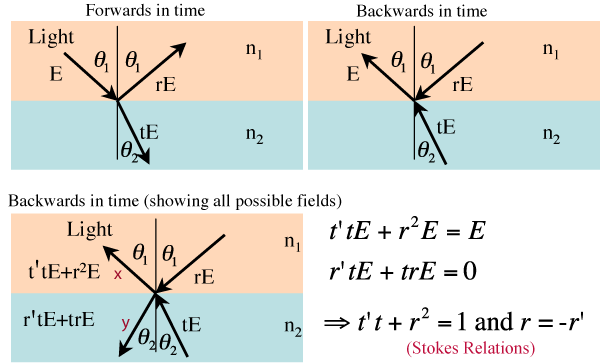Stokes Relationships
The Stokes relations , named after George Stokes , describe in physical optics the relative phase of an electromagnetic wave that is reflected at a boundary between materials with different refractive indices . In addition, they also relate the transmission and reflection coefficients for the interaction. Their derivation is based on the time reversal argument , so they only apply when there is no absorption in the system.
When the incident electric field ( ) is reflected at an interface between two dielectric materials, the amplitudes of the reflected field and transmitted into the second medium result to and , where and are the amplitude reflection and transmission coefficients. Since there is no absorption, this system is reversible (see second figure, where the direction of the rays has been reversed). In the event of an actual reversal of the process, there would be parts of the incident fields ( and ) that are themselves transmitted and reflected at the interface. In the third figure this is represented by the coefficients and . The relationships must now be brought into harmony in such a way that the second and third mapping match, that is, the ray x has the amplitude and the ray y has the amplitude 0. This gives the Stokes relations:
- and
The most interesting result here is . Whichever phase is associated with the reflection on one side of the interface, it is shifted by 180 ° on the other side of the interface. For example, if has a phase of 0 °, the phase is 180 °.
The values of the transmission and reflection coefficient as a function of polarization are represented by the Fresnel equations supplied
Individual evidence
- ↑ a b Hecht, Eugene: Optics . 4th ed. Addison-Wesley, Reading, Mass. 2002, ISBN 0-8053-8566-5 .
- ^ Ariel Lipson, Stephen G. Lipson, Henry Lipson: Optical Physics . 4th ed. Cambridge University Press, Cambridge 2011, ISBN 978-0-521-49345-1 .










